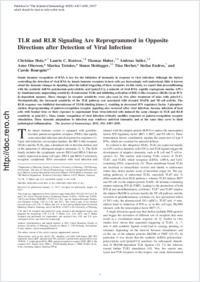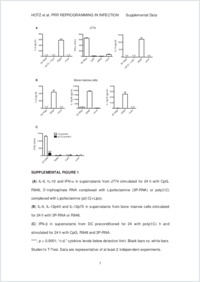TLR and RLR signaling are reprogrammed in opposite directions after detection of viral infection
- Hotz, Christian Department of Medicine, Faculty of Science, University of Fribourg, Switzerland - Division of Clinical Pharmacology, Center for Integrated Protein Science Munich, Ludwig-Maximilian-University Munich, Germany
- Roetzer, Laurin C. Division of Clinical Pharmacology, Center for Integrated Protein Science Munich, Ludwig-Maximilian-University Munich, Germany
- Huber, Thomas Division of Clinical Pharmacology, Center for Integrated Protein Science Munich, Ludwig-Maximilian-University Munich, Germany
- Sailer, Andreas Division of Clinical Pharmacology, Center for Integrated Protein Science Munich, Ludwig-Maximilian-University Munich, Germany
- Oberson, Anne Department of Medicine, Faculty of Science, University of Fribourg, Switzerland
- Treinies, Marina Department of Medicine, Faculty of Science, University of Fribourg, Switzerland
- Heidegger, Simon Division of Clinical Pharmacology, Center for Integrated Protein Science Munich, Ludwig-Maximilian-University Munich, Germany - III Medical Department, Technical University Munich, Germany
- Herbst, Tina Department of Medicine, Faculty of Science, University of Fribourg, Switzerland
- Endres, Stefan Division of Clinical Pharmacology, Center for Integrated Protein Science Munich, Ludwig-Maximilian-University Munich, Germany
- Bourquin, Carole Department of Medicine, Faculty of Science, University of Fribourg, Switzerland
-
11.01.2015
Published in:
- The Journal of Immunology. - 2015, vol. 195, no. 9, p. 4387–4395
English
Innate immune recognition of RNA is key for the initiation of immunity in response to viral infection. Although the factors controlling the detection of viral RNA by innate immune receptors in host cells are increasingly well understood, little is known about the dynamic changes in signaling after the initial triggering of these receptors. In this study, we report that preconditioning with the synthetic dsRNA polyinosinic-polycytidylic acid [poly(I:C)], a mimetic of viral RNA, rapidly reprograms murine APCs by simultaneously augmenting sensitivity of endosomal TLRs and inhibiting activation of RIG-I–like receptors (RLRs) in an IFN-β–dependent manner. These changes in receptor sensitivity were also seen in vivo after treatment of mice with poly(I:C). Mechanistically, the increased sensitivity of the TLR pathway was associated with elevated MAPK and NF-κB activity. The RLR response was inhibited downstream of TANK-binding kinase-1, resulting in decreased IFN regulatory factor 3 phosphorylation. Reprogramming of pattern-recognition receptor signaling also occurred after viral infection, because infection of host cells with Sendai virus or their exposure to supernatant from virus-infected cells induced the same changes in TLR and RLR sensitivity as poly(I:C). Thus, innate recognition of viral infection critically modifies responses to pattern-recognition receptor stimulation. These dynamic adaptations to infection may reinforce antiviral immunity and at the same time serve to limit pathological inflammation.
- Faculty
- Faculté des sciences et de médecine
- Department
- Département de Médecine
- Language
-
- English
- Classification
- Biological sciences
- License
-
License undefined
- Identifiers
-
- RERO DOC 258005
- DOI 10.4049/jimmunol.1500079
- Persistent URL
- https://folia.unifr.ch/unifr/documents/304644
Other files
Statistics
Document views: 90
File downloads:
- pdf: 189
- Supplementary material: 106

